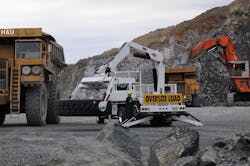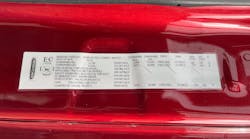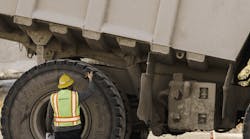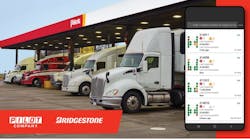Compared to the scarcity of off-the-road (OTR) tires a few years back—when basically all sizes were difficult find—the supply of OTR tires today seems adequate. Some tire manufacturers, in fact, are challenged with excess inventory and excess factory capacity, the result, in part, of diminished demand from the mining sector. At least one machine manufacturer is said to be selling off excess stock of already-mounted quarry-truck tires at bargain prices. If so, these tires could be a windfall for fleet managers who can use them in an appropriate application; but a bargain-priced tire in the wrong application is no bargain.
“OTR tires live in some of the harshest environments we can image,” says Bruce Besancon, vice president, marketing, Alliance Tire Americas. “Without the first and most basic step of selecting the proper tire for the application, that expensive tire can be ruined in a matter of hours.”
Johni Francis, OTR product manager, Titan Tire, can attest to the short life of misapplied tires. He tells of being asked to consult with a Russian mining company that saw new tires on its mining trucks being destroyed in less than 600 hours.
“The mine was trying do its homework by selecting tires adequate for the speeds, loads, and distances involved in the operation,” says Francis, “but they didn’t take into account that the tires were constantly running in highly abrasive material and in a continuously wet environment. They were using a very aggressive, open-lug tread pattern, which wasn’t required, and the lugs dug into the abrasive soil so aggressively that they actually tore loose. Also, the tire compound favored heat-resistance on the haul road, but made the continually wet tires especially vulnerable to cutting injuries.”
Matching tires and applications
OTR tires typically fall into six construction-application categories, the three most prominent being Earthmover (E), Grading (G), and Loader (L). Generally, E-types are for haul vehicles traveling on unimproved surfaces at relatively high speeds for moderate distances; G-types for spreading material over unimproved surfaces at moderate speeds for long distances; and L-types basically for loaders traveling at relatively slow speeds and short distances.
Subdivisions within these basic categories, identified by numbers, define choices regarding such aspects as tread type, tread-to-void ratio, and tread depth—providing tire buyers significant latitude when matching tires to applications. An L2 tire, for example, has a traction-type tread of standard depth and a lug-to-void ratio of 1-to-1, compared with an L5 having a tread type suitable for working in rock, a lug-to-void ratio of 2-to-1, and a tread depth 2.5 times thicker than that for the L2.
Yet other variables are the tire’s basic construction, bias-ply or radial, and the characteristics of the actual rubber (compound) used in its construction. Although tire manufacturers might have a relatively wide selection of proprietary compounds, choices are not always black and white.
“Selecting the correct compound might require some tradeoffs,” says Michael Dembe, market development manager at Camso. “Some compounds are more heat-resistant, some more chunk- and chip-resistant—and the various choices are sometimes at odds with each other. If you need a more cut-resistant tire, for instance, then you might give up some heat-resistance.
“Tire selection requires a robust understanding of the application,” says Dembe, “including equipment type and size; cycle times and distances; terrain, grades, and work-zone layout; types of materials to be handled, their density and abrasiveness; surface conditions in hauling and loading areas; operator techniques and habits; vehicle and tire maintenance practices; operator training; and history of previously used tires.
“A baseline understanding of these variables is critical; once fleet managers have this information, then they can begin to look at the tires themselves—what patterns and compounds, for example, or even brands, in some instances.”
An incident involving an application misstep was related to CE by a quarry equipment manager, who noticed that the sidewalls on a loader’s L5 tires were beginning to split. He replaced the L5s with L3s and solved the problem. The L5s, with “years of tread left,” he says, were installed because someone assumed that using the thickest, toughest mining tires for every wheel loader was the surest way to reduce tire damage and increase tire life.
“That strategy might work if the loader is confined to pit work,” says the manager, “but use it in high-speed load-and-carry work, which this loader was doing, and the flexing sidewalls of the heavy L5s generate so much heat that the tires come apart.”
Eric Matson, manager, global field engineering, Goodyear, reinforces the need for carefully considering loads, speeds, and travel distances when selecting tires.
“Good tire performance begins with good selection,” says Matson. “Choosing the right tire for the application makes all the difference in terms of in-field performance. First, end users must define what the tire will be ‘asked to do.’ After this, we recommend that end users consult with their tire-supplier representative who has the experience to recommend appropriate tires for the equipment and application. Keep in mind that every OTR tire, regardless of application, has a certain ton-mile-per-hour [TMPH] rating that dictates how much weight the tire can carry at a specific speed—and the TMPH rating shouldn’t be exceeded.”
(In wheel loader applications, some manufacturers might use the “work capacity factor” [WCF] for determining a tire’s capacity.)
Yokohama’s Tim Easter, director of OTR sales, adds that the TMPH rating is basically a heat index based on the tire’s compound, and he further reminds equipment owners that if a machine will be moving from job to job and encountering different applications along the way, then the choice of tires should be based on the requirements of the most demanding situation.
According to Les Garner, product development manager, Double Coin Tires, using the wrong tread depth is a classic problem when selecting tires, and notes that “using L5s in an L3 application comes up regularly and results in heat-type separations.” He hastens to add, though, that another application-related consideration is sometimes overlooked.
“Another problem that should be pointed out,” says Garner, “is the misapplication of a tire by using the wrong wheel and wheel components. A wheel with the wrong taper degree will not allow the bead sole area of the tire to seat properly and puts undue stresses on the bead structure, possibly resulting in catastrophic failure. Also, using the wrong flange ring can change the position of the flex point on the sidewall, resulting in sidewall separation or possibly a shoulder—belt edge—separation.”
As Goodyear’s Matson noted, selecting tires usually involves a partnership between the fleet manager and a competent tire dealer, coupled with the tire manufacturer’s expertise. But even with all this grey matter at work, experimentation can still be part of the process.
“On occasion,” says Camso’s Dembe, “there is no ready, obvious answer [emerging from the analysis], and the machine owner and tire dealer might have to partner in tracking a couple of options to see what works best.”
Maintaining the selection
Assuming a conscientious effort to apply tires properly, the unanimous consensus is that maintaining proper air pressure and controlling tire temperatures are primary day-to-day factors that have a significant effect on per-hour costs.
“The No. 1 factor in the life of tires is air pressure,” says Yokohama’s Easter. “Machine owners should keep in mind, also, that if the application of the machine changes, then tire pressures should be reevaluated.”
Sharon Cowart, director of product marketing, Michelin Truck Tires, says that every operation should have a master air gauge against which field gauges used by vehicle operators are calibrated. Cowart suggests pressure checks during a daily tire inspection, which should focus on the tread surface and sidewall; signs of chunking or stone drilling; bubbles and bumps caused by air or debris infiltration; irregular wear; and deep cracks or cuts.
“A tire that is 20 percent below optimal air pressure is considered a flat tire,” says Cowart, “and a tire run under these conditions will experience casing fatigue that could lead to a zipper rupture or catastrophic failure.”
Ron Tatlock, engineering and training manager for BKT Tires, says that both radial and bias-ply tires are designed to have a precise cross-sectional shape (in terms of the location and size of the sidewall bulge) when properly inflated for the application.
“Correct inflation for the load applied maintains the designed tire shape,” says Tatlock. “The tire can deflect as intended under load and achieve the best possible footprint shape and size for maximum traction, flotation, and wear life. Proper sidewall shape under load will best resist sidewall cuts, bruises, and punctures, resulting in minimal heat generation and minimal stress on the tire casing, which increases the potential for retreading.”
Managing heat
Excessive heat, another prime enemy of OTR tire life, can be caused by improper inflation, misapplication, or exceeding an appropriate tire’s load, speed, and distance limitations. The potential effects of excessive heat include “pyrolysis,” a process in which chemical bonds in the rubber disintegrate, weakening the tire’s structure and forming gases that can expand, exploding the tire, or can ignite, setting the tire on fire. Tires remember abuse from overheating (their “heat history”) in terms of a permanently weakened condition.
Given the importance of avoiding overheated tires, fleet managers are beginning to investigate pressure/temperature-monitoring systems that not only can report abnormalities to the operator via the in-cab monitor, but also can report through the machine’s telematics system and provide instant alerts to the fleet manager via a mobile device.
For example, Trimble’s TirePulse Solution system monitors pressure and temperature via valve-stem-mounted sensors and, with an added piece of telematics hardware that can be installed on any make of machine (the Trimble SNM940 module), the system can report this data to machine owners via the web-based Trimble/Caterpillar VisionLink interface.
“As we want to track site productivity,” says Jules Muir, product manager for the TirePulse Solution, “it is important we work across all machine manufacturers and provide add-ons such as TirePulse across the mixed fleet.”
A Caterpillar system, the Cat Tire Monitoring System, is available for tubeless-tire rim sizes R29 and smaller and uses in-tire sensors banded to the rim. Off-board information, says Caterpillar, is available to customers through a subscription to the VisionLink interface.
Practical advice
From the comments we’ve collected from various tire manufacturers and fleet managers, a few practical considerations find consensus when considering an overall tire-management strategy.
Evaluate the importance of every rubber-tired machine in the fleet and the economic effect on the operation if that machine goes down with a bad tire. What are the consequences, for example, if a quarry pit loader has a blowout? The loader is down, three haul trucks are idle, the crusher and processing plant cease operation, and the bin haul truck sits and waits. The cost of downtime, possibly, could run into thousands per hour. And, after the scramble to return the loader to service, the fleet manager can pretty much count on an ensuing head-hunting investigation.
A possible strategy for mitigating the consequences of a key machine going down with a tire issue might include maintaining an inventory of “mission-critical” tires, which have been purchased during an optimum off-season time—when prices are lowest. Coupled with this approach is the advice to have a competent tire dealer, willing to be available 24/7 on a moment’s notice, capable of conducting regular fleet inspections and pressure checks, and equipped to keep all this data online for the fleet manager in a “tire-tracking” system.
“We strongly encourage end users to capture as much data about tire performance as possible, and then to put that data to work for them,” says Goodyear’s Matson. “Proprietary programs available from many tire manufacturers, such as Goodyear’s EMTrack tire-management system, can help accomplish this. Repetitively collecting in-field data about such items as inflation, tread depth, and hours-per-tire eventually gives the end user the ability to monitor and chart important metrics like cost-per-hour, cost-per-ton, and hours-per-32nd. It also can help end users forecast future tire needs and budget accordingly.”
Tire management, however, must deal with yet another variable, which might be the most difficult.
“Among the basics sometimes forgotten,” says Alliance Tire’s Besancon, “is making machine operators aware that they are the No. 1 best—or worst—influence on the life of a tire. Even properly selected and properly maintained tires can’t last with abuse. Operators should be careful to not overload, avoid debris and hazards, avoid sharp turns and short stops, and not turn the wheels when the vehicle is stopped.”





